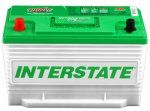Yea...Interstate. If you have the manual for the MT-7, I'd appreciate if you could post the charge specs/profile from the manual.
From their FAQ page:
http://interstatedealers.com/ChargersFAQs.asp
"Do I need a special charger for recharging sealed AGM batteries?
Yes, when recharging sealed lead-acid AGM or Gel-type batteries it is best to choose a charger with a selection specifically for them. These batteries can be overcharged by some chargers that are used for regular or liquid electrolyte batteries. Some of the liquid electrolyte chargers have their internal voltage regulation set too high for AGM or Gel battery."
So what they are saying there (by lumping AGM and Gel together, which is just dumb), is that it's bad to overcharge SEALED batteries. Well...duh.
It's crap like that just adds to the confusion, as it makes it appear that AGM is some special beast that requires a special charger.
Notice on that same FAQ page - in regards to charging, they lump their AGM in with the conventional flooded (which is fine, since most AGMs take the same charge profile as most flooded):
"Powersport:
Conventional Flooded Batteries and AGM/Sealed Valve Regulated Batteries:
Determine the state-of-charge with a voltmeter. Valve-regulated batteries are fully charged at approximately 12.80-13.00 volts after sitting for 1-2 hours in a static condition (no loads or charging).
Batteries with voltage between 12.50–12.80 may need a slight charge. These batteries are below a 75% state-of-charge and a maintenance charge will keep the plate material fresh and prevent sulfation.
Batteries with voltage less than 12.50 should be recharged at the recommended rates. Charge time for these batteries will range from 5-13 hours.
Batteries below 11.50 volts require longer recharge times (20 hours) and often require special charging techniques. Voltage readings this low are often an indication of internal damage and usually requires replacement. At the very least, these batteries have very high internal resistance and can require higher voltage and special equipment to overcome the high resistance. Use care when attempting to recharge low-voltage batteries. Batteries that gas heavily and emit a strong odor are most likely damaged.
Select a charger that is approximately 1/10th the amp hour capacity of the battery. The proper charger levels can normally be found on the battery label. Use a charger designed for motorcycle/powersport batteries. Constant current or manual chargers are not recommended."
My search-**** is pretty good, but it's difficult to find specific charge profiles for Interstate batteries - partly because their web site is a piece of crap where they don't stick to any standard nomenclature...half the time there are hyphens in the product names/numbrers and half the time there are spaces.
Here is a .pdf for an Interstate 35ah deep cycle AGM which lists the max charging current as less than or equal to 14a (just about C/2, but that's max, not "recommended"...they typically recommend C/10) and the max charge/eq voltage as 14.5v-14.9v - which is in the ballpark for any lead-acid battery except Gel type and which Odyssey's 14.7v recommended is in the sweet spot right in the middle of that range.
"Equalization and Cycle Service
Charging and Current Limits
≤ 14 A, 14.5 - 14.9 volts"
http://www.interstatebatteries.com/cs_estore/content/product_info/specs/dcm0035.pdf
Here's the charge specs for something called the UAGM8D, which I would assume is an 8d size AGM battery - but I can't find the bloody thing on their web site:
"Charging recommendation for the UAGM8D (rated at 250 AH at the 20-hour rate):
Voltage of the Battery System - 12
Charging Current - C/10
Bulk Charge Voltage - 14.4v
Absorption Voltage - 14.4v
Absorption Time in Hours - 2 to 4
Float Voltage - 13.2
Equalization Voltage - 14.4v
Equalization Time in Hours - 2"
http://www.batteries-faq.com/activekb/questions.php?questionid=1
Note that that battery has a 250ah capacity (well, yea...it's an 8D size) and they recommend a C/10 charge rate.

